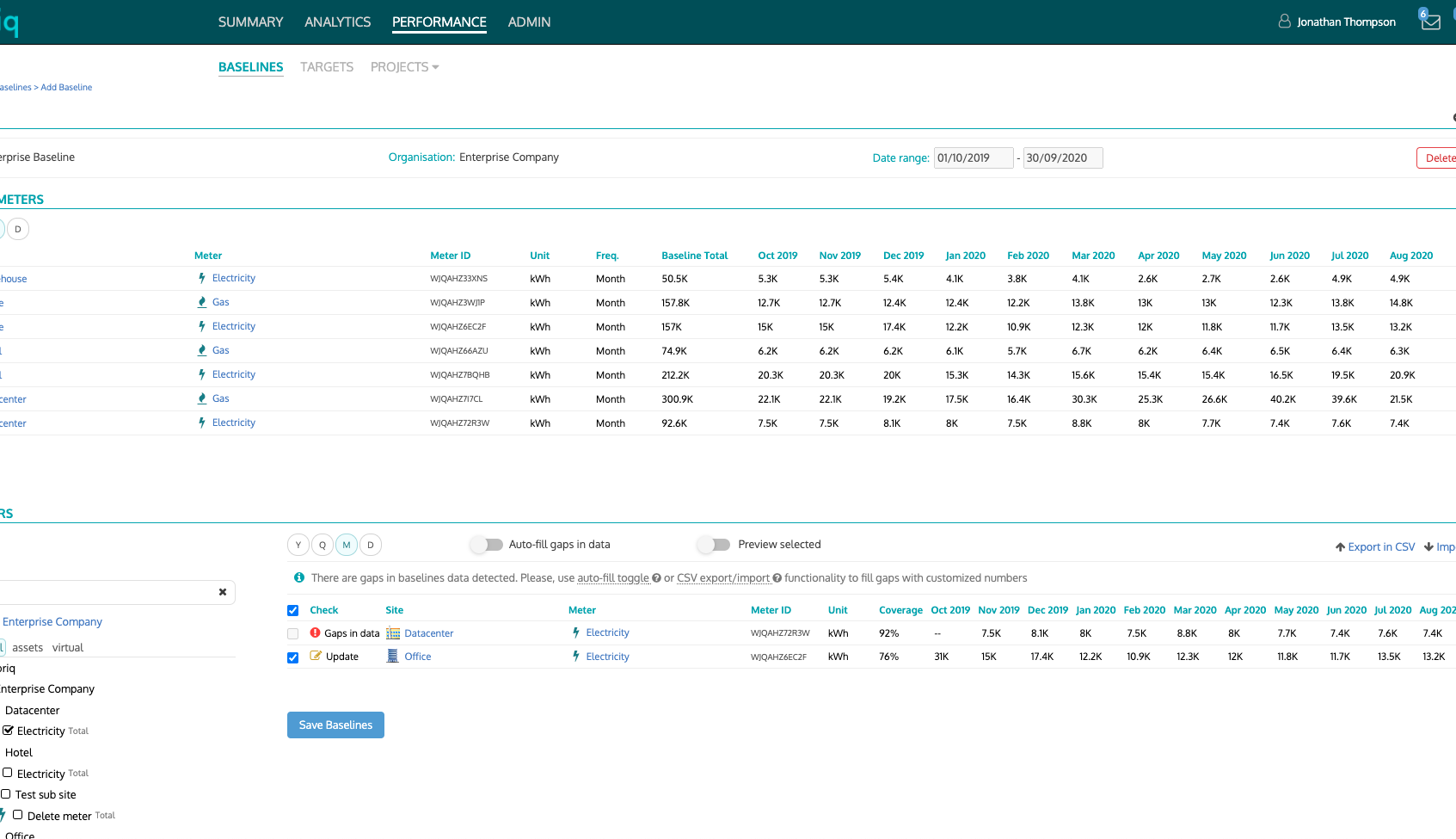
Measure and Track Progress Towards Your Net Zero Carbon Goals With Fabriq’s Enhanced Baselines and Targets Module
Following a tidal wave of Net Zero Carbon commitments over the past 12 months, we decided it was time to enhance the functionality that these trail-blazing organisations would need to achieve their objectives. CEOs across the globe are staking their reputation on, let’s be fair, pretty audacious sustainability goals. But how many have considered, let alone fully understand, the importance of a data-led approach to meeting Net Zero Carbon objectives.
In the past, there have been two very different ways of setting targets when it comes to energy consumption in buildings. In one camp, you had the energy managers, optimising efficiencies down at meter level and using intricate IPMVP standard models to validate the impact but often failing to see the bigger picture. On the other hand, sustainability managers were setting long term organisational-level goals, but with very little understanding of the complexities involved in achieving them. It is this disconnect that has held back overall progress.
Through the lenses of Net Zero Carbon this has all changed. It simply had to. A commitment to being Net Zero Carbon by 2050 (or it now seems on trend to say even earlier!) is a combination of a long-term organisational goal and a very tangible means of measurement. There is of course much deliberation about the true meaning of “Net Zero”, but with increasing scrutiny on greenwashing, there won’t be a place to hide for much longer. Organisations will have no choice but to reduce their impact on the environment.
With that said, we wanted to provide the tools that an owner or operator of a portfolio of buildings would need to get started. Something that would take care of the “heavy lifting” whilst still leaving enough flexibility for specific processes.. We understand that the perfect solution is far from defined, as many organisations are still finding their feet. But we fully intend to evolve this functionality over time in collaboration with our partners and customers, to build a world-class data platform for organisations who want to become Net Zero Carbon.
Baselines
The process of setting a baseline is not something that should be taken lightly. It’s the very foundation of any sustainability objective. Our aim was to find the perfect balance between allowing users to set a baseline in as few clicks as possible, whilst providing enough feedback to ensure the baseline is reliable.
The most notable change we've made to how baselines and targets are set in Fabriq is we have now enabled a combination of both a top down and bottom up way of working. This means targets can be set at organisational level, but the targets are pushed down to site and meter level where they can be fine-tuned based on the specific nature of those buildings.
The two most important factors when selecting a baseline are a reliable, complete dataset and a representative period of time, prior to any work taking place or major changes. You want your baseline to be relatable - i.e you should be able to accurately measure and test future initiatives in relation to that period of time.
When setting a baseline in Fabriq, users are provided immediate feedback on the quality and completeness of data covering their chosen period. From there they can adjust the period to find a complete data set or take further steps to fill data gaps or edit specific readings.

Additionally, depending on the time horizon you’re working with, the baseline can be set at various resolutions to increase or decrease the sensitivity. In other words, you can set a baseline at monthly or quarterly resolution if you only intend on setting a 5-10 years target. Alternatively, if you plan to track your performance against the baseline more rigorously, you can set the resolution to weekly, or even daily, enabling you to really fine-tune performance.
Data gaps can be filled in two ways. Firstly, users can use the built in “gap fill” toggle to perform a simple pro rata using readings either side of the gap. This is great for smaller gaps in data and where the data is fairly consistent.
For larger gaps in data or for when a user might want to override periods of data, the import / export functionality can be used. This enables users to export the baseline in its current form, make changes in a spreadsheet, and then import the data back in as a baseline. This is also a great way to import baselines that were generated outside of the platform into Fabriq.
Once a baseline is saved in Fabriq, it is stored as a separate data stream and will not be affected by incoming data or by changes made elsewhere in the platform. Having said that, if new data is added to the platform that would make the baseline more reliable, an individual meter's baseline can be updated by selecting that meter and re-saving the baseline. As portfolios change over time, sites and meters can be added and removed to baselines to ensure a like-for-like comparison can always be achieved.
Targets
Once a solid baseline is in place, it’s time to start setting targets. In Fabriq, there are four key components to setting a target. Firstly, a user must select the baseline. A target is directly linked to a baseline (meaning you can’t set a target without a baseline) as it must represent the starting point from which you plan to make a percentage reduction. Any changes to the linked baseline will feed through to and may impact the target.
Secondly, the target end date, or the date by which you intend to have met the goal. In other words, the “2030” in “we are going to be net zero carbon by 2030”. The target measurement period begins directly after the baseline period ends.
Next up is the unit you wish to set the target in. All baseline are set in the raw measurement values for consistency, but targets can be set in either energy consumed (kWh) or greenhouse gas emissions (CO2e). This is an important distinction to make. Top level goals are almost always set in terms of emissions but this extra layer of conversion can add some complications with changes in conversion factors

Finally, and probably most importantly, the percentage reduction you plan to achieve. Now this works in two ways. To begin with, a user can define a portfolio level target that is applied evenly to all sites. Just hit save and you’re done.
Alternatively, a user can fine tune each meter’s target based on what they know about the site. Perhaps the portfolio contains one “state of the art” low carbon building with little room for improvement, and another older building that is due a complete retrofit. It therefore wouldn’t be sensible to assume these buildings would contribute evenly to the overall goal.
Tracking Performance
For decades, energy managers have used industry benchmarks or modelled consumption based on past consumption for individual meters as a point of measurement. In the world of Net Zero Carbon things have changed.
With the overarching goal of reaching Net Zero Carbon portfolio wide, we wanted to build out a process aligned to that specific objective. This is why we built the target tracking page that enables users to check the status of their top-level portfolio targets and how they are performing to date, in relation to the overall goal.

Each target is marked as either on-track or off-track, which is based on whether performance is following the expected trajectory. Our users then have the option to jump into specific site and meter targets and evaluate if action needs to be taken.
Baseline and target information also feeds through into other areas of the platform, such as our “Trends” module which is typically used for deep dives into building performance data. From here, users can take baseline and target data and run it over the top of actual consumption data. There is more flexibility here to get into the detail of deviations away from baseline at much higher data resolutions.

What’s Next?
These improvements are a big step forward in enabling organisations to manage and track their way to Net Zero, but for us, it’s just the beginning. We’re already thinking about how to build on this foundation and take things to the next level. As this remains fairly unknown territory, we’re working closely with our customers to better understand the tools they’ll need on their journey to Net Zero Carbon.
If you're interested in seeing our Baselines and Targets module in action then please get in touch about a demo!

